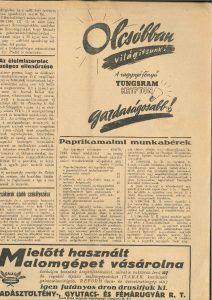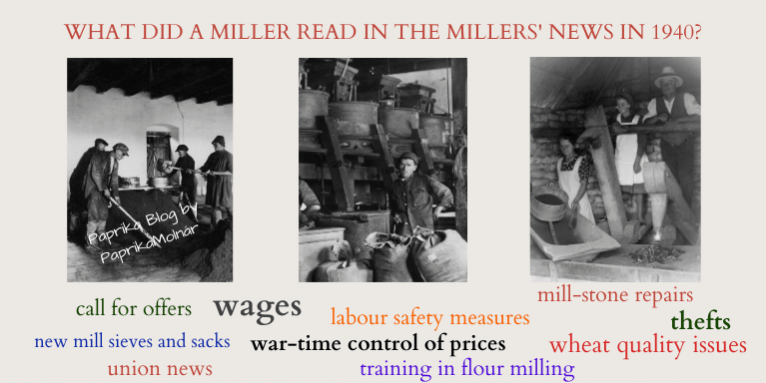Recently, various museums initiated a series called „The item of the Month” and it becomes increasingly popular on social media. This initiative wants to highlight some of the more interesting pieces of the collection or those that are not part of the exhibition. In our Paprika Museum we too collected many artefacts – and there is plenty to tell – therefore we are starting a similar series. Our first “pick” is a publication featured on November 1st, 1940 in the Millers News.
A special choice – a special item
Why this particular item? Our museum started on a defying moment when we were offered to purchase a true legacy. Over 10 years ago, in 2008, Albert Molnár bought the legacy of the Szánthó family from a collector. This collection of documents paints a complete picture of every day life in the paprika mills in Szeged. At PaprikaMolnár Kft, they thought this legacy deserved to be the core of a Paprika Museum featuring the history of paprika. So therefore as a first pick it was not difficult for us to chose this legacy as the item of the month.
Innovative Thinking, Technical Talent, Miller Patents, Mechanization, Participation in Education, Sánthó & Sons, St. Michael’s, Paprika Ribillion, Chruch Building Efforts… These are all key subjects of the Szánthó family legacy to which we have also referred in several of our blogposts.
The Millers News
Mihály Szánthó, and his sons József and Lajos, of course, were interested in a frequent appearing newspaper about the miller profession which was published and edited by Ferenc Császár. The paper appeared 3 times per month on the 1st, 10th and 20th of each month. By 1940, the Millers News was already in its 6th volume and also available in Röszke.

Picking „the item of the month”: Millers News from 1940
Like many other paprika growers, Mihály Szánthó and his sons turned to paprika processing after they mastered the grain-miller profession. The close relationship between these two milling activities is illustrated by the fact that the selected issue of Millers News features articles on topics like: Evaluation of wheat quality in the milling industry; Wheat Grading Theory; (Quality of wheat: value for its use in frying); International report on the grain market (USA, Canada, Argentina); Regulation of grain prices in the returned (eastern and Transylvanian) areas; Tender announcements for flour transport… etc.
It also features a snapshot of the historical-political background of that period. An article reports that Prime Minister Teleki would involve interest groups, including representatives of the milling industry, in the Constitutional Reform.
Millers News was, of course, also the primary forum for craftsmen of similar professions and interests. The enormous load of advertisements – including everything from milling supplies, marine dryers, waste oil and regenerators to bearings and Ganz rollers – illustrate this feature of the page.
For us, however, the description of wages in the paprika mill is the most relevant. The article is worth reading in the context of the historical background, the period of World War II. A detail of the decree reads: “… the amount of time spent on work shall not be less than the minimum wage per time of performance within the meaning of this Decision in the appropriate workplace and group of wages.” trying to offset the effects of inflation. Fortunately today, war is long gone, but the issue of wages is still actual.
Tetszett a cikk? Ha szeretne még paprikás és fűszeres témában, heti rendszerességgel cikket olvasni, hírt kapni az ÚJ paprika elkészültéről, iratkozzon fel hírlevelünkre. Subscribe to our Blog and enjoy our Paprika Poster.







